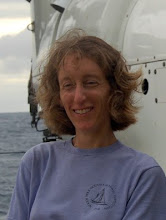14-Sep-2010. Today our Chief Scientist Kojima-san returned to Snail site to recover our JAMSTEC collaborators’ demersal plankton pump on Dive 1228. Accompanying Kojima-san on the dive was our cruise mascot, “Gori-san” (shown in photo). We are hoping that Gori-san brought us good luck and that we will have a lot of biology work to do this evening, the last night at sea. I would like to again thank the Captain and everyone on board R/V Yokosuka who helped make this cruise such a great success. Arigatou gozaimasu (ah-ree-gah-tohh goh-zah-ee-mah-soo).
 |
| Sunset rays above Philippine Sea |

















